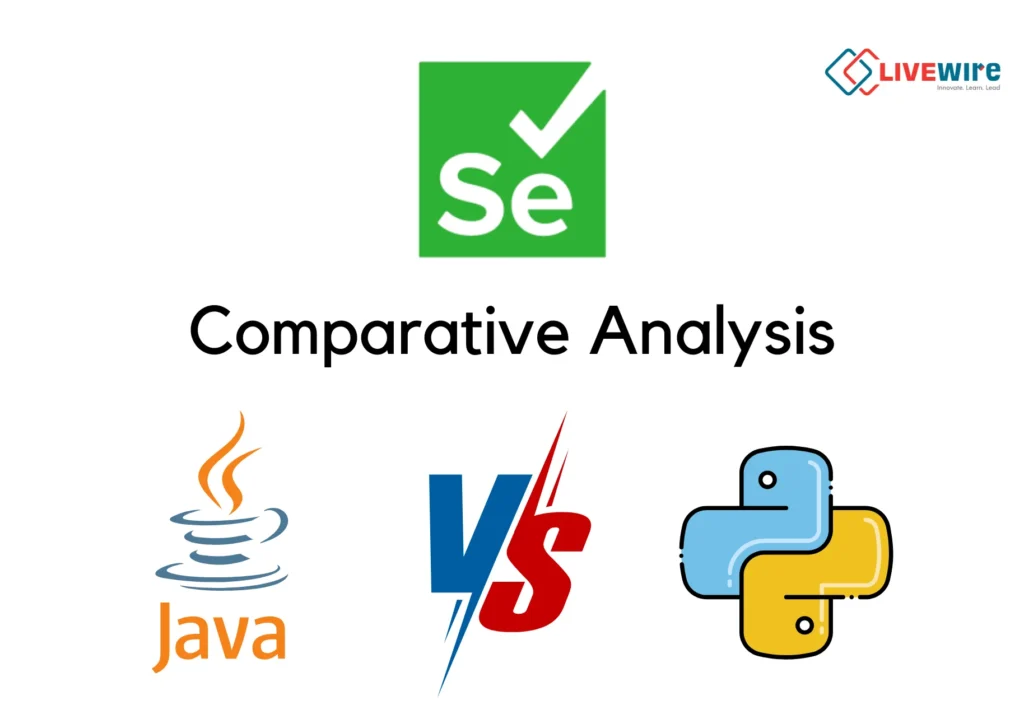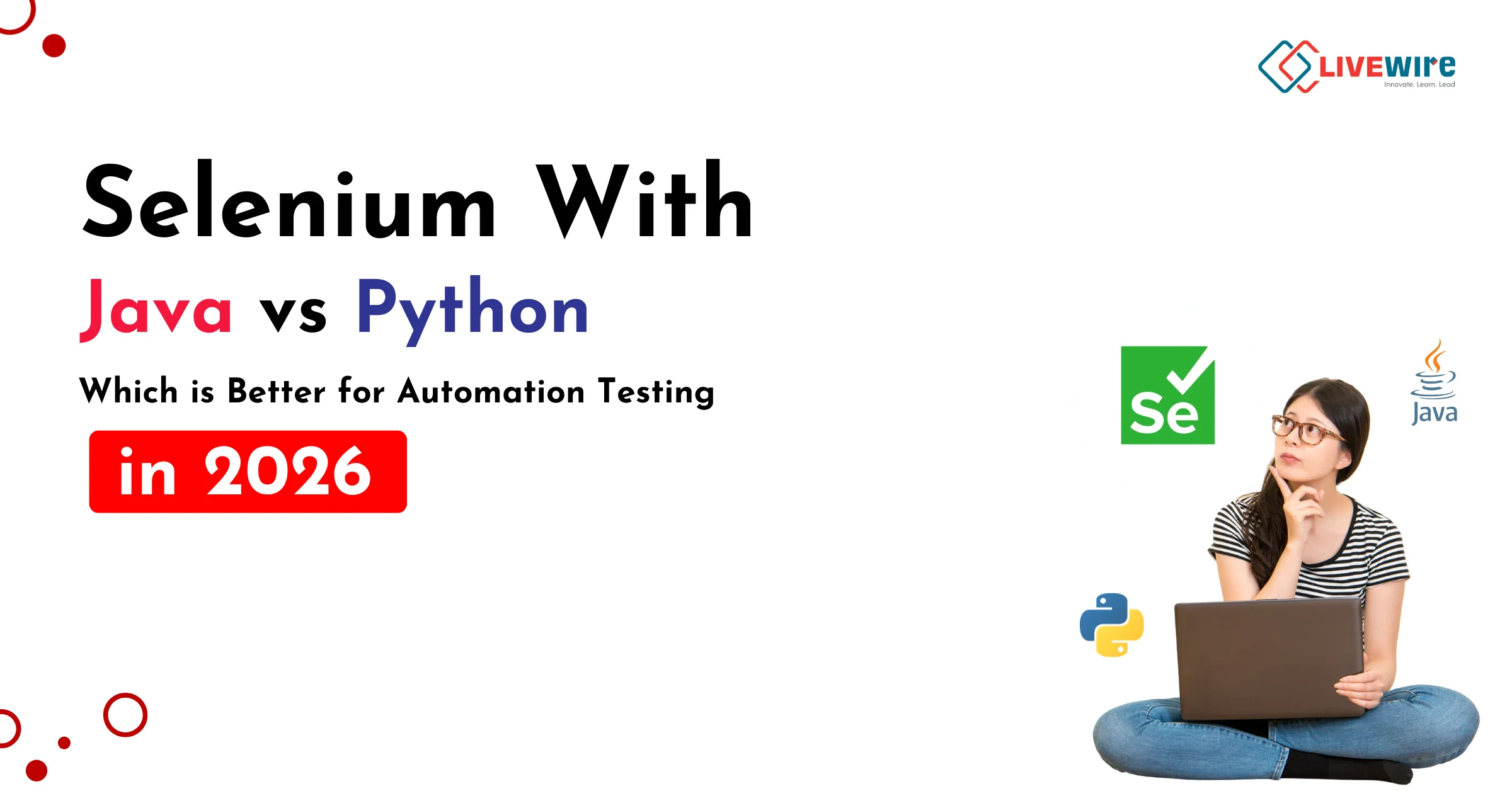Automation testing has developed very fast, in 2026 it is still one of the most popular frameworks: Selenium. As enterprises are moving towards automation tools for software testing, the decision of Selenium with Java vs Python has become more important. Which programming language will you choose, will have an impact on learning curve, framework integration, maintainability and even job opportunity.
Selenium with Java has dominated the industry for many years but because of its simplicity and ease of use, Selenium with Python is becoming the top choice. This article seeks to compare each and help testers and companies make an informed choice.
Contents
- 1 What Is Selenium?
- 2 Selenium with Java – Strengths and Use Cases
- 3 Selenium with Python – Strengths and Use Cases
- 4 Selenium with Java vs Python – A Comparative Analysis
- 5 Choosing the Right Language for Selenium Automation Testing in 2026
- 6 Learning Selenium from Scratch – How to Get Started
- 7 Livewire’s Selenium Training Programs – Master Automation Testing in Chennai
- 8 Career Opportunities in Selenium Automation Testing
- 9 FAQs for Selenium with Java vs Python
What Is Selenium?

Selenium is an open-source testing tool specifically designed for automating web applications for testing purposes across different browsers and platforms. Selenium is available for Java, Python, C# and JavaScript that you can run it in browser. Its flexibility is the reason, why it is one of the most popular automation tools for testing software. Selenium Java- Testers leverage Selenium to do functional, regression and even accessibility testing with Selenium Java. This adaptability, together with its healthy community support, has made Selenium one of the foundational stones for contemporary automation testing with Selenium.
Key benefits of Selenium include:
- Cross-browser compatibility
- Open-source availability
- Integration with Other Frameworks (TestNG, Junit & Pytest)
- Scalability for enterprise applications
In 2026, Selenium still heads automation testing for it flexibility and exponential number of users.
Selenium with Java – Strengths and Use Cases
Selenium with Java is the one combination which has been around for a long period and has been accepted by many. With the huge success of Java in software and its solid OOP background, it’s a no-brainer for testers. Additionally, the support of strong testing frameworks like JUnit and TestNG has helped build a sound structure for Java automation testing.
Strengths of Selenium with Java:
- Extensive community support and resources
- Starting as amazing/ good for Selenium automation testing… Mature ecosystem for Python/PY.
- Great for enterprise class, randomized large complexity testing
- Strong compatibility with CI/CD pipelines
Use Cases:
- Complex enterprise web applications
- Accessibility testing using Selenium Java
- Cross-browser regression testing
Legacy Java-based applications typically use Selenium with Java to work easily in the organization’s environment.
Selenium with Python – Strengths and Use Cases
Over the past few years, Selenium with Python has been gaining momentum because of the simplicity and easy learning of Python. It has a compact syntax and this enables testers to write scripts at a faster rate than Java. This makes it ideal for beginners as well as teams focusing on rapid automation.
Strengths of Selenium with Python:
- Shorter learning curve, making it ideal for newcomers
- Seamless integration with PyTest and Robot Framework
- Efficient for automation testing using Python Selenium
- Strong support for AI and data-driven testing
Use Cases:
- Quick automation prototyping
- Lightweight web applications
- Cross-functional teams with diverse technical backgrounds
The rise of Python in data science and AI also complements its use in automation testing Selenium with Python, making it a future-proof skill in 2026.
Selenium with Java vs Python – A Comparative Analysis

Choosing between Selenium with Java vs Python requires a multi-dimensional assessment. The following comparative table highlights the key differences:
Category | Selenium with Java | Selenium with Python |
Performance & Execution | Compiled on JVM, slightly faster in CPU-heavy parallel runs | Interpreted, but browser I/O dominates so differences are minimal |
Development Speed & Maintainability | Verbose code, more boilerplate but enforces strong structure for large projects | Concise syntax, easy to learn, faster script writing and maintenance |
Frameworks & Ecosystem | Mature support with TestNG, JUnit; rich enterprise ecosystem | Integrates seamlessly with PyTest, Robot Framework; growing plugins |
CI/CD & Tooling | Strong support with Maven/Gradle, enterprise pipelines, better for legacy systems | Lightweight packaging, easy cloud integration, modern CI friendliness |
Parallelism & Scalability | Robust multithreading via JVM, predictable large-scale test grid execution | Limited by GIL in pure threading, mitigated by multiprocessing or cloud services |
Community & Market Demand | Larger community, widely used in big enterprises | Growing community, highly demanded in startups, AI-driven projects |
Specialised Use Cases | Favoured for enterprise regression and accessibility testing using Selenium Java | Excellent for AI, data-driven automation, and automation testing using Python Selenium |
Best Choice When | Enterprise scale applications, already installed Java stack, rigid type-safety. | Quick development, easy learning, cross-functional teams. |
Learning Curve | Steeper, suitable for experienced testers | Easier, beginner-friendly |
Speed of Script Writing | Relatively verbose | Concise and faster |
Framework Support | TestNG, JUnit | PyTest, Robot Framework |
Community Support | Larger and more mature | Growing rapidly |
Enterprise Adoption | High in large companies | Increasing in startups and AI-driven projects |
This head to head comparison demonstrates that there is no better language for Selenium automation testing task, it strictly depends on the complexity of your project, who are the team members and how you hav planned for future.
Choosing the Right Language for Selenium Automation Testing in 2026
Choosing between Selenium Java vs Python in 2026 depends on:
- Project Size and Complexity: Java is for large projects, Python is good for smaller ones.
- Team Skills: Infrastructural teams having Java developers opt for Selenium with Java; cross-functional ones will tend to choose Python.
- Career Aspirations: Java may be beneficial for more general enterprise positions. For some future-proof AI and automation, Python is a long-range solution.
Ultimately, both languages remain relevant. It should be based on your testing needs, industry requirements and business organization.
Learning Selenium from Scratch – How to Get Started
It can be daunting to learn Selenium from scratch if you’re a beginner, but the following step-by-step guide makes it easy:
- Learn the basics of Selenium testing tool
- Pick a language: Selenium with Java vs Python
- Understand web locators and Selenium WebDriver
- Explore frameworks like TestNG or PyTest
- Practice with real-world automation projects
Many free resources, tutorials, and training programs are available online, but choosing guided learning accelerates progress.
Livewire’s Selenium Training Programs – Master Automation Testing in Chennai
If you are looking to specialise in Selenium automation testing, Livewire offers professional training programs tailored to industry requirements. Their courses cover:
- Selenium automation testing with Java
- Automation testing using Python Selenium
- Framework integrations (TestNG, JUnit, PyTest)
- Real-world case studies and projects
Livewire’s tested and proven structured syllabus serves as the backbone for acting as the portal for aspiring, as diverse career options are available. Whether you love selenium with java or python, Livewire has got you covered.
Career Opportunities in Selenium Automation Testing

There is a strong demand for Selenium automation testers that will continue up to 2026. Selenium is used for testing in companies involved in almost all domains of the industry. Career roles include:
- Automation Test Engineer
- QA Analyst
- Test Automation Architect
- Accessibility Testing Specialist
Both Selenium with Java and Selenium with Python open doors to high-paying roles. Java-based roles are often abundant in enterprises, while Python-based roles are popular in startups and AI-focused organizations.
When it comes to Selenium with Java vs Python, there is no easy answer. Choose Selenium with Java when you intend to do your test activities on a larger scale in an enterprise, whereas Selenium with python is ideal for anyone who is new or for teams requiring quickness. Those who can do both will be in greatest job demand by 2026. The best for you will ultimately depend on your project’s requirements, the way that you learn best, and your career goals.
FAQs for Selenium with Java vs Python
The power of Selenium with Python is simplicity, that makes it more suitable for beginners and for brazilian companies vintage at making spaghetti code could led to the generation of monsters.
Yes, you can switch. The two languages share Selenium WebDriver, so moving from Java automation testing to Python Selenium is a fairly simple task.
Java has been around for a long time in the industry, particularly for large enterprise space with legacy infrastructure. Even hiring ads are favoring people with some Java skills for Selenium automation roles.
Yes, it is possible to move from Java to Python. Although the syntax changes, the fundamentals of Selenium still apply here in Automation testing. Python syntax is more comfortable and straightforward to understand after you know Java, according to most developers.
Long time presence in the industry (especially large enterprises with legacy system tend to stick with Java). Even today, most job posts ask for Java knowledge for Selenium automation positions.
But Python is fast gaining popularity, especially at startups and tech companies trying to keep development cycles lean. It is easy to learn and extremely flexible so many organizations opt in for python.
